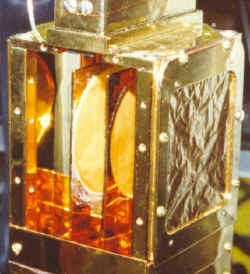One Less Bottleneck for Fusion

You don’t need temperatures as hot as the Sun for nuclear fusion. Rather than squeezing nuclei together with high temperature and pressure, the muon catalyzed fusion (µCF) approach lets a muon do the squeezing–by forcing a pair of nuclei into close quarters as the muon orbits at a short distance. Some researchers hope to make it practical for power generation in the future, although they have also been interested in the muonic molecule itself. A collaboration reporting in the 21 August PRL has now directly observed a dramatic enhancement in the formation of the muonic molecule, an essential process considered a “bottleneck” for µCF, using a new approach: They created a beam of muonic tritium atoms to get a clean, isolated measurement of the exotic molecule created just before fusion.
The goal in nuclear fusion is to force a deuteron ( d = proton + neutron) and a triton ( t = proton + 2 neutrons) into such close proximity that the strong nuclear attraction between the two pulls them together, overriding their electrical repulsion. In µCF, the muon does this by first replacing the electron orbiting a triton, to make muonic tritium, or µt. The µt then corrals one of the d nuclei of a molecule( 2 d’s + 2 electrons) to form dµt, without separating from the other, more distant d nucleus and two electrons. The dµt is so tightly bound that it acts like a single nucleus in this unusual, 3-nucleus, “compound molecule” that is the critical intermediate before fusion occurs.
A single muon zipping through a medium enriched with deuterium and tritium can catalyze perhaps 150 fusions, but ten times that number would be needed for a reactor to “break even” in energy. One of the bottlenecks that limit the µCF process is the formation of the dµt because the molecule has trouble getting rid of the kinetic energy of the µt. Experiments beginning in the 1980s suggested that if the µt comes in with enough energy, the dµt can form in an excited state and deliver the extra energy to specific rotations and vibrations of the 3-nucleus molecular complex. Theories predicted that this “resonant enhancement” would be optimized with a µt having 1 eV of energy, but the only way to control its energy was indirect–by heating the medium, which could only achieve the equivalent of 0.05 eV.
Now an international collaboration led by Glen Marshall of TRIUMF in Vancouver, Canada, has dramatically demonstrated the resonant formation of the dµt at ten times the rate of previous experiments by creating a µt beam. The TRIUMF lab’s muon beam was aimed at an “upstream” target of tritium-enriched hydrogen followed by a “moderation” layer to slow down the µt’s produced in the first layer. The µt’s then flew through an 18-mm gap–which the team used to clock their speed–before hitting the final, “downstream” target of deuterium cooled to 3 K. Since the tritium is radioactive, team member Makoto Fujiwara, now of the University of Tokyo, calls the experiment “cold fusion with hot atoms.”
The researchers cleanly measured the number of fusions (which produce detectable alpha particles) at each µt energy. Their data confirm the predictions of a dµt enhancement near 1 eV and also probe the energy structure of three vibrational states of the compound molecule, because the likelihood of fusion depends on the µt energy matching the vibrational energies.
James Cohen of Los Alamos National Laboratory in New Mexico says the new data strongly suggest that the first bottleneck in µCF can be eliminated, and only one other remains–the tendency of the muon to “stick” to the outgoing alpha particle after fusion–although “that one would seem to be less amenable to control,” he says. Still, Cohen is most interested in the basic physics of forming the compound molecule, whether or not µCF leads to a practical device. He’s also very impressed with the experiment itself. “Theorists think something can’t be done experimentally, and clever experimentalists are able to do it anyway,” he says, noting that a decade ago ”I’d have said I couldn’t imagine any way of doing it.”
More Information
TRIUMF: Canada’s National Laboratory for Particle and Nuclear Physics
A recent ab initio calculation of the formation of dµt: V. Zeman, E. A. G. Armour, and R. T. Pack, “Treatment of the tµ+ reaction by the methods of quantum reactive scattering,” Phys. Rev. A 61, 052713 (2000)


